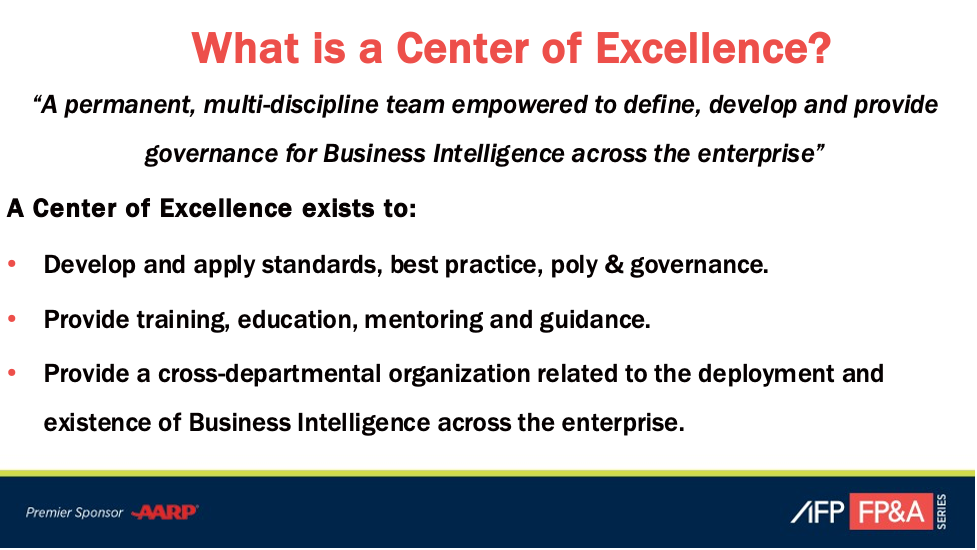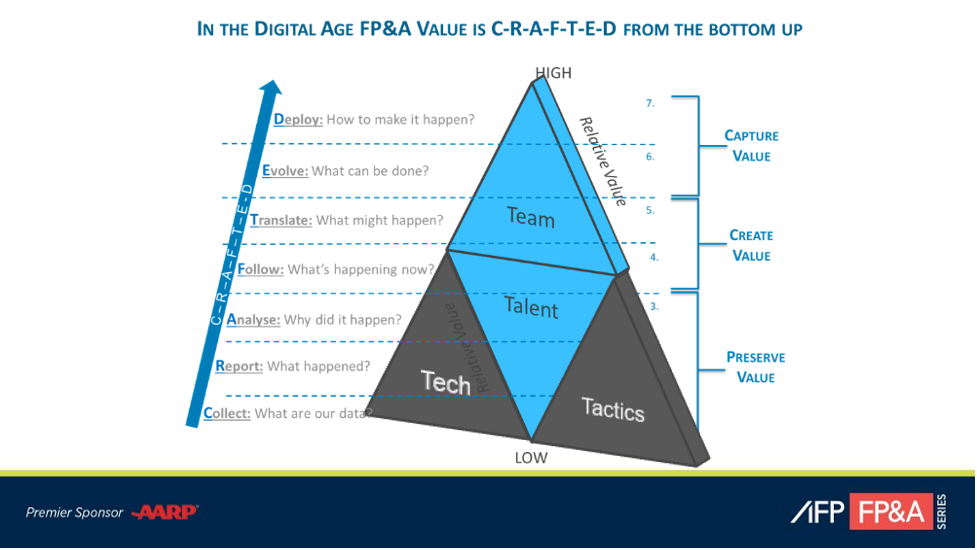Articles
We Took a Deep Dive into Data; Here’s What We Learned
- By Bryan Lapidus, FPAC
- Published: 6/30/2022

The AFP FP&A Series is a half day, virtual mini conference designed to take a deep dive into one cutting-edge topic per event. The first event was titled, “Get Your Data Right” and was held in June and exclusively sponsored by AARP. Finance leaders from, ABM, AARP, Collectiv, Dell and Microsoft each presented case studies describing how they have moved their organizations forward and built the foundation for future grown based on getting their data house in order. Here is a brief summary:
Implementing Data-Driven Decision-Making
Kayla Davis, vice president and head of M&A for ABM Industries, set the tone for the day’s sessions by describing how data transformation projects need to be rooted in business needs and not viewed as independent data projects. In 2017, ABM Industries rolled up its sleeves and got ready to clean up the data. “We took a team of the best of the best inside the organization, those who knew all our data sources and could navigate all the different systems. We also hired some outside consultants to help us clean up as much data as possible. We spent a lot of time and money and we made good progress for about a year,” said Davis.
“However, two years later, our data situation reverted back to where we were before, and in some cases, it got even more confusing.
“Then in 2020, our leadership team got together again to discuss the next phase of our transformation — rooted in our new, centralized management model. We started by setting a vision for the project based on company goals, followed by what matters to the clients and the employees who deliver to the clients and what could be enabled/supported by internal processes, which morphed into our three-year aspiration.”

Delivering Data as a Service
Companies often struggle to balance control / consistency with freedom to innovate. Jesse Todd, group finance manager, Finance Data & Experiences Team for Microsoft, explained the challenge, their approach, and the analytical framework that allowed it to happen: “We wanted to make sure every single person in an analytical role, whether they sat in finance or marketing or sales or engineering, was able to look at the same data — data that had been conformed around a standard analytical framework, described how we actually looked at business performance and was delivered through a single corporate BI entity to each of those organizations. This was the foundation of our data strategy, and we called it Developing Discipline at the Core,” said Todd.
“At the same time, we wanted to create a system that would support flexibility at the edge, because we knew coming up with one dashboard that would meet every need for every business scenario wasn’t something we were going to be able to do. So, we aligned on that core of discipline: formed and federated data that can be considered the single source of truth and can apply to any situation. In order to do this, we had to spend time understanding what that analytical framework would look like.”

Taming the Wild West of Your Data for Reporting
Greg Gillespie, principal with Collectiv, picked up exactly where Jesse Todd ended. Delivering that last mile of reporting data to the end user is a challenge, and Gillespie says the best way to start is to apply the mindset of creating a Center of Excellence (COE) around reporting.
“A center of excellence, also called a center of practice, is a permanent, multidiscipline team empowered to define, develop and provide governance for business intelligence across the enterprise. That’s a mouthful. Think of it like this: at the end of the day, just a governing body that sits in your organization to handle three things.
“First, it's a place to maintain your standards, your policies, and your best practices around data and reporting. Second, it's a place that your community of users, whether that's an analyst, a CEO or a CFO — anybody in your organization — can go to get training and education on the data, how you report against information, and where my reporting lives.
“And third, at the end of the day, this team is made up of individuals, and they’re not just from finance or FP&A. It's made up of individuals from various departments across your organization. So I could have people from marketing, sales, finance, operations, and that's important because if we have individuals from all across our organization as part of this group, it sets the standard of how we're going to roll reporting and data out. We're going to get better buy-in.

“We're going to get better buy-in because it's not just centered in one department, which causes a lot of grumbling inside our organization, and everybody thinks, well, we're just building sales reports because everybody in the COE is from sales. If we're pulling people from each organization, then we have an entire group of power users filtered throughout the business, and then everybody feels like they're getting their two-cents in.”
How Data/Digital is Reshaping FP&A
Andrew Codd, founder and producer of #SITN Finance Podcast and Finnetics®, and consultant to Dell Technologies said that the way data and digital tools are reshaping FP&A is by opening up the opportunity for people to do better — and more interesting — work. For Dell, this meant replacing the data aggregation work at the bottom of the traditional hierarchical pyramid with technology and specialized teams, and changing job descriptions for those team members to roles that allow them to create and capture value.
“Likewise for our team members, where do they want to engage?” said Codd. “What type of work in the FP&A world engages them, allows them to enjoy their careers, and moves them to join us in rowing in the right direction. You're not just preserving the organization as it exists. If you've identified an opportunity, and if you do something about it, you're propelling your journey up the rungs of the value ladder, and you're crafting something that shines bright like a diamond.
"As leaders in FP&A and as finance professionals, this is what we're trying to do: We’re trying to find opportunities to create value, and perhaps even go capture it, using digital technologies and digital tactics.”

What to Talk About When They Talk About Digital Transformation
Creating the corporate-wide momentum for data and digital transformation is requires leadership from the top. In a fireside chat with Scott Frisch, executive vice president, COO and CFO of AARP, AFP’s Bryan Lapidus, FPAC, director of FP&A Practice, asked how to create common ground across different departments, each with its own goals, motivations and incentives.
“In our case, our digital transformation was really pushed by our CEO, knowing that if we didn't do this, we weren't going to be as successful as we possibly could be in the future. Understanding the components of what this digital transformation entails is very important to getting the project started. It’s important to communicate to your staff about the need for this major disruptive activity, while also running the business. You know that the future is where you want to go, but you still have to get up in the morning and go to work and do your job. You're going to have all this disruption everyday, so communication, communication, communication is key. It's one thing we've learned from the pandemic: You can't communicate enough.”
Copyright © 2024 Association for Financial Professionals, Inc.
All rights reserved.

